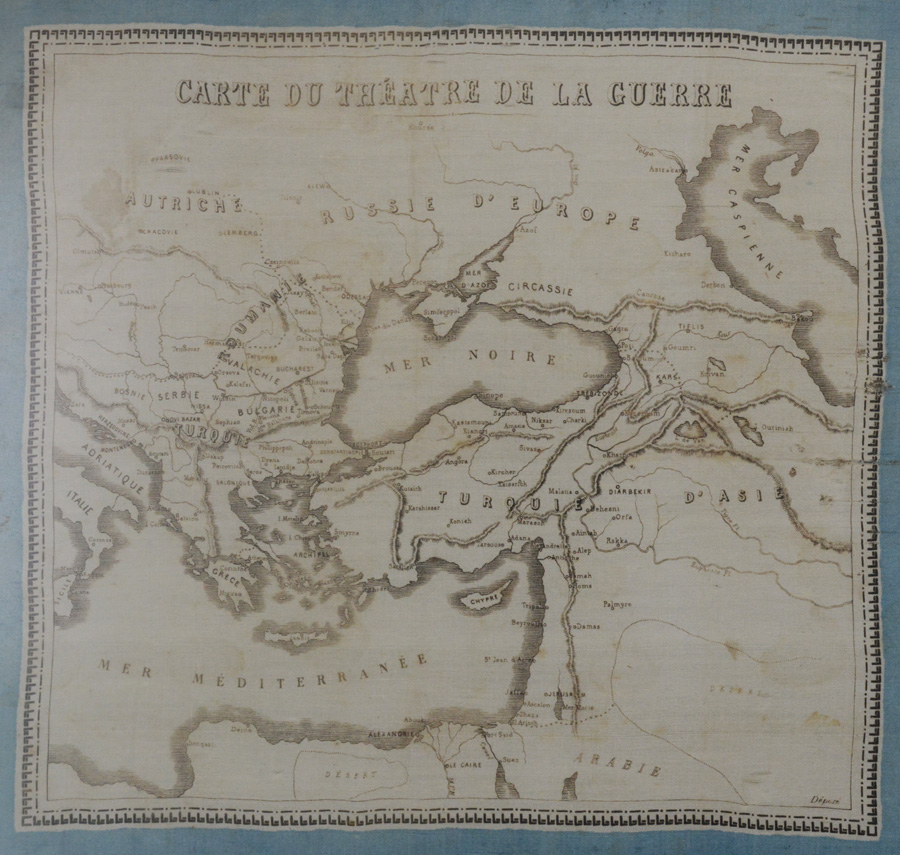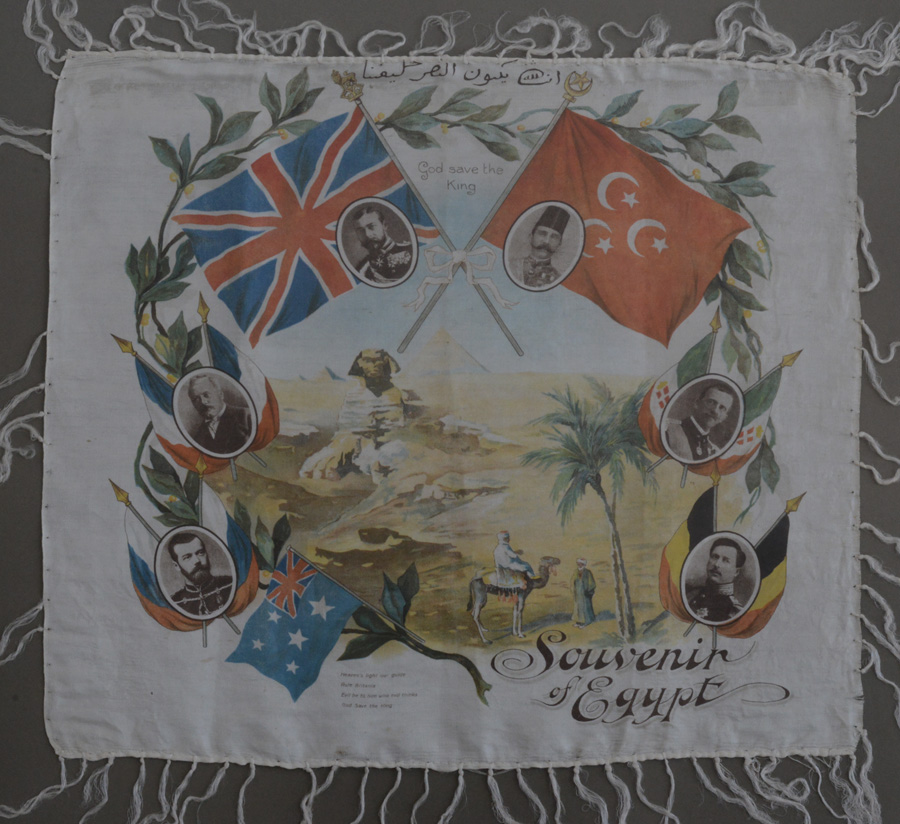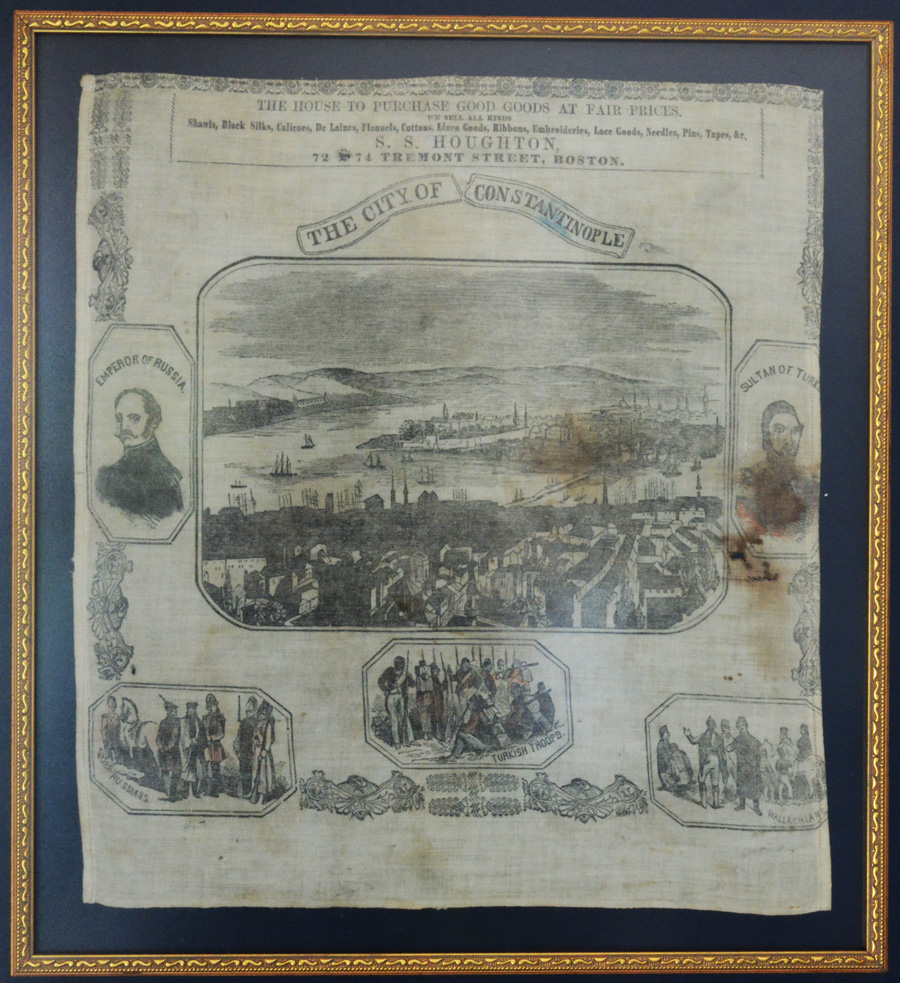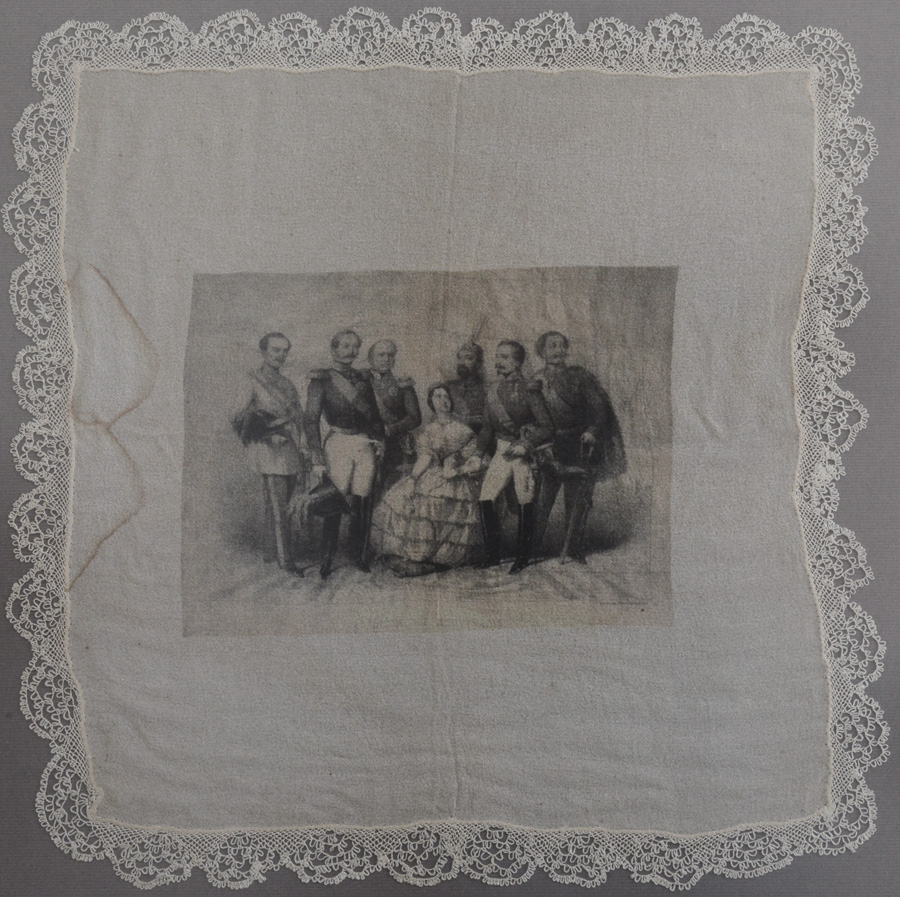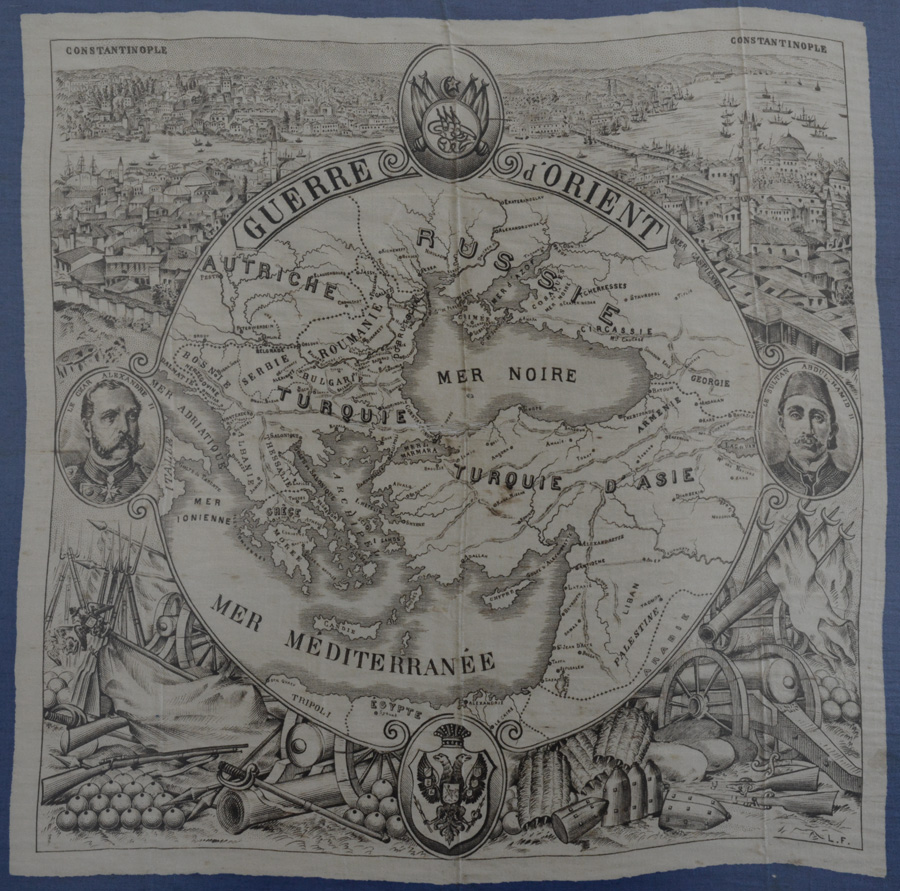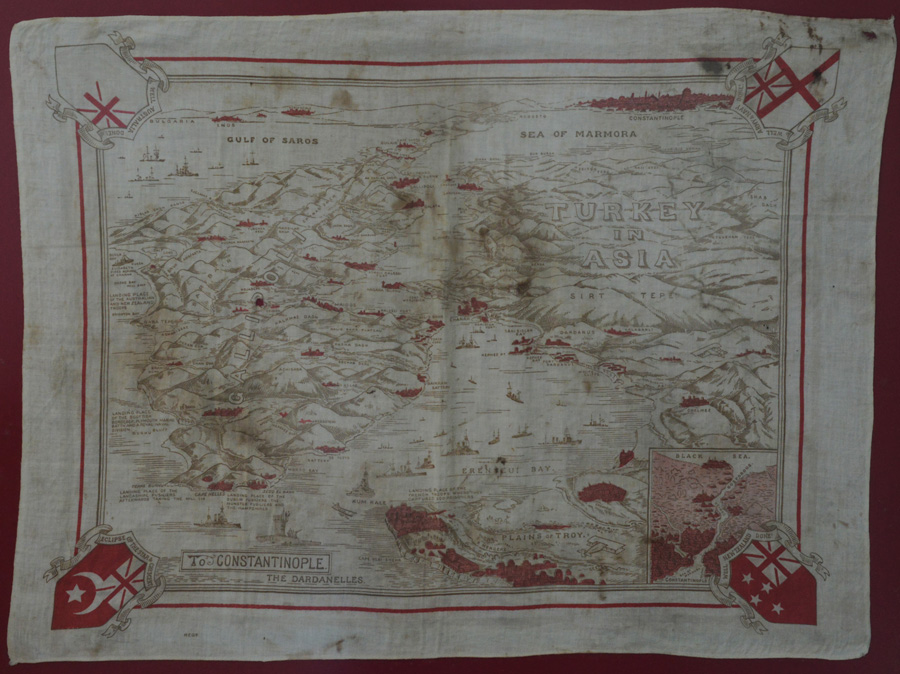
Ephemera
Souvenir Handkerchiefs
The production of souvenir handkerchiefs can be traced to the 17th century, with designs including depictions of victories in battle, royal events, performers, maps and unusual events. These designs could help to satisfy patriotic sentiments or signify particular allegiances. The move to carrying handkerchiefs in a more concealed manner could also allow them to become an ‘unexpected’ or witty statement rather then an accessory that required close co-ordination with the rest of the user’s clothing. Depending on the intricacy of the design, once the printing blocks were prepared, production could be relatively brisk and economical. This allowed manufacturers to respond quickly to topical events. However, as the popularity of a commemorated event may be short-lived, manufacturers had to be cautious about the extent of production, to avoid being left with a surplus of unfashionable or dated designs that would be difficult to sell. Because the topicality of events was limited in duration, some handkerchiefs subsequently became collectors’ items. The items listed here are not intrinsically Levantine in character, but would no doubt chime with the local communities who knew great events were playing out in their geography and these handkerchiefs provided a relatively cheap way to record these moments where only the richest could commission paintings and similar other visual markers of the passage of time.
It is not clear which war this referring to but the text for 'Turquie' extending to Bosnia would mark it before 1878 when they lost the province.
This handkerchief was clearly marketed to both Western and Eastern communities, with the top Arabic script stating ‘If God wills he will assist our Caliph (Sultan)’, and below ‘God save the King’. The Egyptian flag depicted here dates this to between December 1914 and October 1917 when the British on the pretext of the outbreak of the WWI, not recognising the Ottoman sovereignty on Egypt, which had become nominal by that stage, replaced the Egyptian Khedive Abbas Hilmi Pasha with his uncle Hüseyin Kamil Pasa as 'Sultan'. Thus the country became a ‘Sultanate’ breaking its final links with the Ottoman Empire. Sultan Hüseyin Kamil’s portrait is visible on top of the Egyptian flag, next to it the British Flag with the King George V, and the other allies France with its president at the time Raymond Poincaré and the other ally the Russian Czar Nikolai Romanov, the Italian King Vittorio Emanuele III, the Belgian King Albert I. The Australian flag is also added at the bottom for good measure. The fact that there is Arabic / Islamic sentiment on this handkerchief points to the virtual certainty this was made locally, though at the time Egypt would have had no shortage of expatriates, Levantines, refugees and soldiers from all over the Allied powers world.
This handkerchief was produced by the USA, Boston based department store during the time of the Crimean War (1853-1856), though USA was not involved, some of the local population would still have close ties to Britain and some possibly trade ties to Turkey. Around the picture showing Constantinople are historical figures of the time, the Russian Czar Nicholas I, the Ottoman Sultan Abdülmecit and on the bottom representing the different forces from both sides groups of soldiers from Russia, Turkey and Wallachia.
Another commemorative handkerchief of the Crimean War, this time showing an idealised group composition of the big players at the time. Sitting in the centre is Queen Victoria (reigned 1837-1901), just behind her the Ottoman Sultan Abdülmecid (reigned 1839-1861), surrounded by various British and French generals and on the right Napoléon III (Louis-Napoléon Bonaparte, the first Head of State of France to hold the title of President).
The Eastern War is referring to the Russo-Turkish War (1877–1878), with a panoromic view of Constantinople in the background. Once again portraits of the leaders of the two belligerent nations feature with the Russian Czar Alexander II and the Sultan Abdülhamid II. The Ottomans lost this war with the new states in the Balkans, Serbia, Montenegro and Romania becoming independent. The Ottoman armies were almost totally defeated and this brought the weak government further to seek sanctuary with Western powers, Britain and later Germany. By this stage the Ottoman Empire had a considerable foreign and Levantine community where such keep-sake items would find a ready market.
This handkerchief seems to be designed for military buffs of the time of the Dardanelles landings, the Gallipoli campaign (17 February 1915 - 9 January 1916) during WWI. This piece was clearly manufactured in that less than 1 year period as there is no inkling of the effective defeat of the Allied force that had to be evacuated. There is a lot of detail with strategic points, landing points etc. indicated and named and an inset map of Constantinople, the ultimate destination indicated. The corners of this composition are representative of the various main forces (excludes the French, so it is clearly not made in France), the Naval ensigns of Britain, Australia and New Zealand. The other flag on the lower left was probably what was designed for post occupation Istanbul, which didn't happen in this battle, but Central Powers defeat in 1918, allowed it.
The Turkish word for handkerchief is ‘mendil’, clearly a borrowed word from the Genoese dialect ‘mandillu’, (mantellom from Latin) probably itself derived from Greek ‘mandylion’ the face of Jesus, one of the earliest representations venerated in Edessa (Urfa) in Eastern Turkey, which arrived in Genoa in the 14th century and still displayed in one of its churches. The mandylino was given to the Genoese directly from the Byzantine Emperor in Constantinople and since then it is preserved in the Church of San Bartolomeo degli Armeni a Genova. So the Italian word became mantello that has a completely different meaning from the original one. Decorated handkerchiefs also had an early religious connotation, so the word derived from the East like the icon, then spread to the East to Turkish with trade networks which the city had for centuries.
These and other handkerchiefs from the collection of Oğuz Aydemir will be displayed in the basement gallery of Agora Shopping Centre, Izmir - 26 January - 5 February 2018 - poster. The 125 piece collection, unique to Turkey, will then be donated to the Sadberk Hanım museum in Istanbul.

